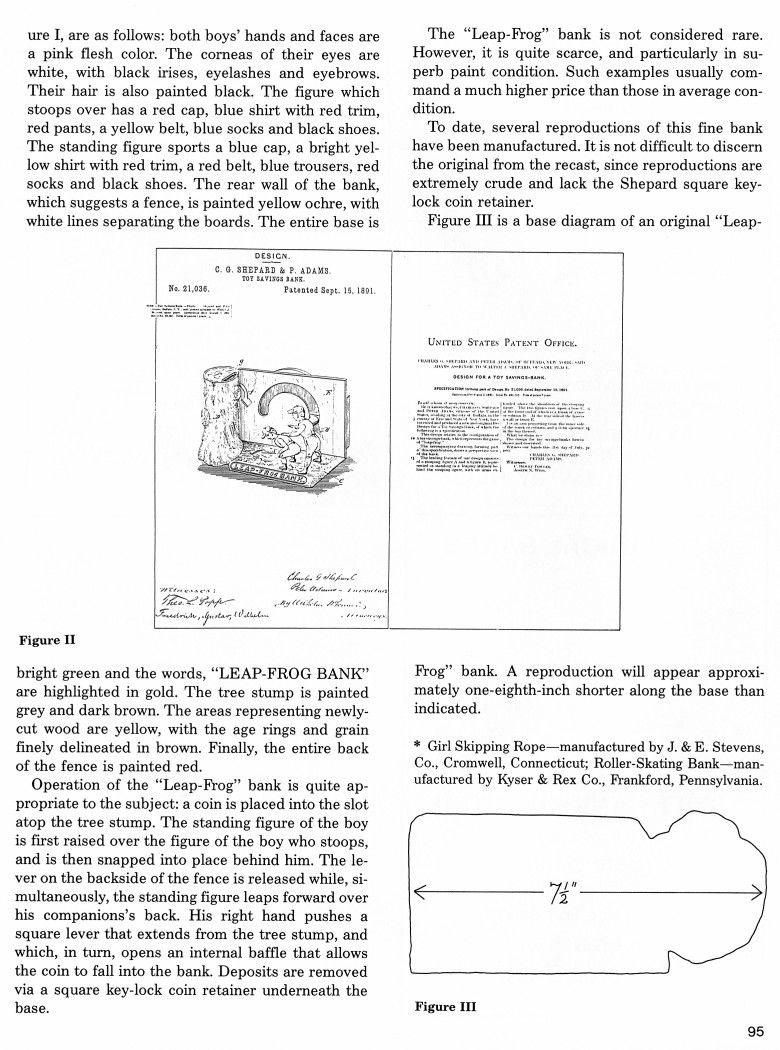|
The Leap-Frog Bank
by Sy Schreckinger – ANTIQUE TOY WORLD Magazine – September,
1990
There are those penny banks which reflect a
period of time in which life was far less complex a time when children
could be delighted and amused with simpler pleasures. One such mechanical,
the "Leap-Frog" bank (Figure I) portrayed children at play.
Interestingly, this mechanical is one of only three manufactured antique
banks* that utilized this particular subject matter. Considering its
appeal to the young, it appears odd that designers of that period did not
employ that theme more frequently.
The "Leap-Frog" bank was invented by Charles G. Shepard and Peter
Adams, who were granted Design Patent Number
21,036 (Figure II) on
September 15, 1891. Comparison of both the final production bank and the
patent drawing with its description, Figures I and II, will reveal that
its manufacturer, Shepard Hardware Company, of Buffalo, New York, adhered
closely to the patent design. In addition, Shepard Hardware may be
commended for craftsmanship and artistic skills, as exhibited in their
designs and painted decorations. Examination of any of their banks
through a magnifying glass indicates exquisitely executed facial details,
enabling one to understand why, to date, Shepard remains unequalled in the
art of mechanical bank decoration.
Unfortunately, this fine paint work cannot always be appreciated. Unlike
most other bank manufacturers of the time, Shepard omitted the process of
undercoating prior to painting their banks. Inevitably, this resulted in
a loss of much of the paint due to heat, moisture and excessive handling.
The "Leap-Frog" bank has no casting or color
variations. The colors of the bank, as pictured in Figure I, are as
follows: both boys' hands and faces are a pink flesh color. The corneas of
their eyes are white, with black irises, eyelashes and eyebrows. Their
hair is also painted black. The figure which stoops over has a red cap,
blue shirt with red trim, red pants, a yellow belt, blue socks and black
shoes. The standing figure sports a blue cap, a bright yellow shirt with
red trim, a red belt, blue trousers, red socks and black shoes. The rear
wall of the bank, which suggests a fence, is painted yellow ochre, with
white lines separating the boards. The entire base is bright green and the
words, "LEAP-FROG BANK" are highlighted in gold. The tree stump is painted
grey and dark brown. The areas representing newly-cut wood are yellow,
with the age rings and grain finely delineated in brown. Finally, the
entire back of the fence is painted red.
Operation of the "Leap-Frog" bank is quite appropriate to the
subject: a coin is placed into the slot atop the tree stump. The standing
figure of the boy is first raised over the figure of the boy who stoops,
and is then snapped into place behind him. The lever on the backside of
the fence is released while, simultaneously, the standing figure leaps
forward over his companion’s back. His right hand pushes a square lever
that extends from the tree stump, and which, in turn, opens an internal
baffle that allows the coin to fall into the bank. Deposits are removed
via a square key-lock coin retainer underneath the base.
The "Leap-Frog" bank is not considered rare. However, it is quite
scarce, and particularly in superb paint condition. Such examples usually
command a much higher price than those in average condition.
To date, several reproductions of this fine bank have been
manufactured. It is not difficult to discern the original from the recast,
since reproductions are extremely crude and lack the Shepard square
key-lock coin retainer.
Figure III is a base diagram of an original "Leap‑Frog" bank. A
reproduction will appear approximately one-eighth-inch shorter along the
base than indicated.
* Girl Skipping Rope — manufactured by J. & E. Stevens, Co., Cromwell,
Connecticut; Roller-Skating Bank — manufactured by Kyser & Rex Co.,
Frankford, Pennsylvania.
|


